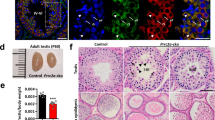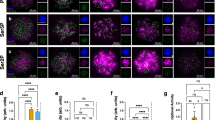Abstract
Chromatin packaging in mammalian spermatozoa requires an ordered replacement of the somatic histones by two classes of spermatid-specific basic proteins, the transition proteins and the protamines1. Temporal expression of transition proteins and protamines during spermatid differentiation is under translational control, and premature translation of protamine 1 leads to precocious nuclear condensation and sterility2. We have previously suggested that the double-stranded (ds) RNA binding protein Prbp (encoded by the gene Tarbp2) functions as a translational regulator during mouse spermatogenesis3. Here we show that Prbp is required for proper translational activation of the mRNAs encoding the protamines. We generated mice that carry a targeted disruption of Tarbp2 and determined that they were sterile and severely oligospermic. Using immunohistological analysis, we determined that the endogenous Prm2 mRNA and a reporter mRNA carrying protamine 1 translational-control elements were translated in a mosaic pattern. We showed that failure to synthesize the protamines resulted in delayed replacement of the transition proteins and subsequent failure of spermiation. The timing of Prbp expression suggests that it may function as a chaperone in the assembly of specific translationally regulated ribonucleoprotein particles.
This is a preview of subscription content, access via your institution
Access options
Subscribe to this journal
Receive 12 print issues and online access
$209.00 per year
only $17.42 per issue
Buy this article
- Purchase on Springer Link
- Instant access to full article PDF
Prices may be subject to local taxes which are calculated during checkout





Similar content being viewed by others
References
Meistrich, M.L. in Molecular Biology of the Male Reproductive System (ed. Kretser, D.M.) 67–97 (Academic Press, San Diego, 1993).
Lee, K., Haugen, H.S., Clegg, C.H. & Braun, R.E. Premature translation of protamine 1 mRNA causes precocious nuclear condensation and arrests spermatid differentiation in mice. Proc. Natl Acad. Sci. USA 92, 12451–12455 (1995).
Lee, K., Fajardo, M.A. & Braun, R.E. A testis cytoplasmic RNA-binding protein that has the properties of a translational repressor. Mol. Cell. Biol. 16, 3023–3034 (1996).
St Johnston, D., Brown, N.H., Gall, J.G. & Jantsch, M. A conserved double-stranded RNA-binding domain. Proc. Natl Acad. Sci. USA 89, 10979–10983 (1992).
Braun, R.E. Temporal translational regulation of the protamine 1 gene during mouse spermatogenesis. Enzyme 44, 120–128 (1990).
Gatignol, A., Buckler, W.A., Berkhout, B. & Jeang, K.T. Characterization of a human TAR RNA-binding protein that activates the HIV-1 LTR. Science 251, 1597– 1600 (1991).
Park, H. et al. TAR RNA-binding protein is an inhibitor of the interferon-induced protein kinase PKR. Proc. Natl Acad. Sci. USA 91, 4713–4717 (1994).
Gatignol, A., Buckler, C. & Jeang, K.T. Relatedness of an RNA-binding motif in human immunodeficiency virus type 1 TAR RNA-binding protein TRBP to human P1/dsI kinase and Drosophila staufen. Mol. Cell. Biol. 13, 2193– 2202 (1993).
Fajardo, M.A., Haugen, H.S., Clegg, C.H. & Braun, R.E. Separate elements in the 3´ untranslated region of the mouse protamine 1 mRNA regulate translational repression and activation during murine spermatogenesis. Dev. Biol. 191, 42–52 (1997).
Fajardo, M.A., Butner, K.A., Lee, K. & Braun, R.E. Germ cell-specific proteins interact with the 3´ untranslated regions of Prm1 and Prm2 mRNA. Dev. Biol. 166, 643– 653 (1994).
Stanker, L.H., Wyrobek, A., McKeown, C. & Balhorn, R. Identification of the binding site of two monoclonal antibodies to human protamine. Mol. Immunol. 30, 1633–1638 (1993).
Alfonso, P.J. & Kistler, W.S. Immunohistochemical localization of spermatid nuclear transition protein 2 in the testes of rats and mice. Biol. Reprod. 48, 522– 529 (1993).
Schumacher, J.M., Lee, K., Edelhoff, S. & Braun, R.E. Distribution of Tenr, an RNA binding protein, in a lattice-like network within the spermatid nucleus in the mouse. Biol. Reprod. 52, 1274–1283 (1995).
Leblond, C.P. & Clermont, Y. Spermiogensis of rat, mouse, hamster and guinea pig as revealed by the "periodic acid-fuschin sulfurous acid" technique. Am. J. Anat. 90, 167–216 (1952).
Oakberg, E.F. A description of spermiogenesis in the mouse and its use in analysis of the cycle of the seminiferous epithelium and germ cell renewal. Am. J. Anat. 99, 391–413 ( 1956).
Russell, L.D., Ettlin, R.A., SinhaHikim, A.P. & Clegg, E.D. Histological and Histopathological Evaluation of the Testis (Cache River Press, Clearwater, Florida, 1990).
Braun, R.E., Peschon, J.J., Behringer, R.R., Brinster, R.L. & Palmiter, R.D. Protamine 3´-untranslated sequences regulate temporal translational control and subcellular localization of growth hormone in spermatids of transgenic mice. Genes Dev. 3, 793–802 ( 1989).
Acknowledgements
This work was supported by grants to REB from the NIH/NICHD (HD27215) and (U54 HD12629), the latter through a cooperative agreement as part of the Specialized Cooperative Centers Program in Reproduction Research. A.H.F.M.P. was supported by a TALENT fellowship from the Netherlands Organization for Scientific Research and from the Mellon Foundation.
Author information
Authors and Affiliations
Corresponding author
Rights and permissions
About this article
Cite this article
Zhong, J., Peters, A., Lee, K. et al. A double-stranded RNA binding protein required for activation of repressed messages in mammalian germ cells. Nat Genet 22, 171–174 (1999). https://doi.org/10.1038/9684
Received:
Accepted:
Issue Date:
DOI: https://doi.org/10.1038/9684
This article is cited by
-
Sexually dimorphic expression and regulatory sequence of dnali1 in the olive flounder Paralichthys olivaceus
Molecular Biology Reports (2021)
-
MicroRNAs control mRNA fate by compartmentalization based on 3′ UTR length in male germ cells
Genome Biology (2017)
-
The role of TARBP2 in the development and progression of cancers
Tumor Biology (2016)
-
Ca2+/Calmodulin-Dependent Protein Kinase IV Promotes Interplay of Proteins in Chromatoid Body of Male Germ Cells
Scientific Reports (2015)
-
Trbp regulates heart function through microRNA-mediated Sox6 repression
Nature Genetics (2015)



